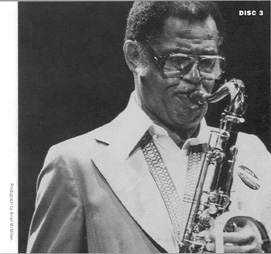| Mosaic Select MS-014, 3 CDs ©Laurence Svirchev |
| Dexter Gordon loved to make inventively sweet introductions to concert audiences. They were short ditties, sometimes in rhyme, designed to set the audience at ease about the song to come. Deep-voiced and articulating slowly, here is how he introduces It’s You or No One:
“For me,
The ride, mostly fast tempo runs or ballad romances, continues through 19 cuts. Gordon frequently threw in delightful quotes from other compositions and some may consider this device to be clichéd. I’d argue differently. His use of quotes have nothing to do with running low on improvisational ammunition, but stem from his deep appreciation of melody and his profound knowledge of song lyrics. Gordon’s music grew out of the bop revolution when lyrics mightily influenced the way jazz musicians played. Gordon’s appreciation of spoken- and sung-words helped form not only his melodic eloquence but his emotional warmth on the horn. Most of the cuts are over twelve minutes long with extended tenor sax and piano workouts and just a few bass and drum solos. The counter-balance to hearing Gordon‘s seeming endless inventions is that the arrangements take on a certain repetition: melody, tenor solo, piano solo, reprise of melody, and out. Perhaps this is because the cuts were culled from the live recordings over several tenures at the Keystone Korner in 1978-79. But each cut taken on its own is a gem. Pianist George Cables not only provides the antithesis to Gordon’s steadiness, but also renders the gems polished and sophisticated with a sheen of abstraction. Take his solo, with no supporting rhythm section, on As Time Goes By. He deconstructs the basic melody into short segments played at slow tempo. In between the segments are fast runs frequently broken up by stop time intervals. Each run gets longer until there is high tension in the music, and then he returns to a full melody statement, the rest of the band kicks in, and the ballad becomes a love song again. Overall, this is one of the music sets that can make a listener happy there is no longer a needle to wear out the LP grooves. If your name is Sam, you’ll find yourself frequently muttering to yourself, “Play it again.“ |
|
|
|||
Dexter Gordon: Nights at the KeystoneComments are closed. |
|||
|
Copyright © 2025 Misterioso - All Rights Reserved Powered by WordPress & Atahualpa |
|||
 It’s a nicely-told musical joke that also resolves a key question for the band. Gordon, as usual, opens the composition with the melody, but he rapidly throws in a little quote from Surrey with the Fringe on Top, the part of the lyric that goes “Chicken, geese, and ducks better scurry.” And then it’s off for the ride of a solo.
It’s a nicely-told musical joke that also resolves a key question for the band. Gordon, as usual, opens the composition with the melody, but he rapidly throws in a little quote from Surrey with the Fringe on Top, the part of the lyric that goes “Chicken, geese, and ducks better scurry.” And then it’s off for the ride of a solo.